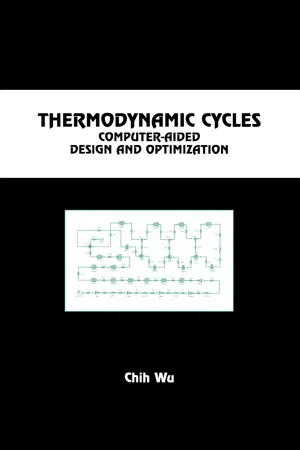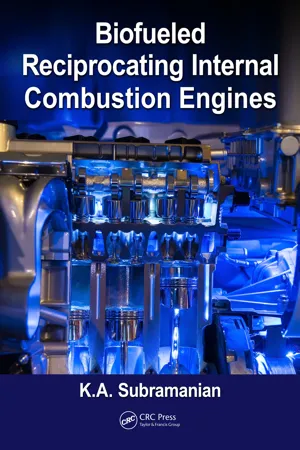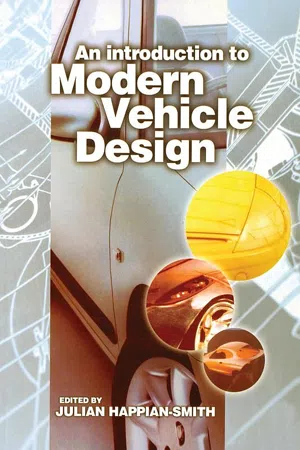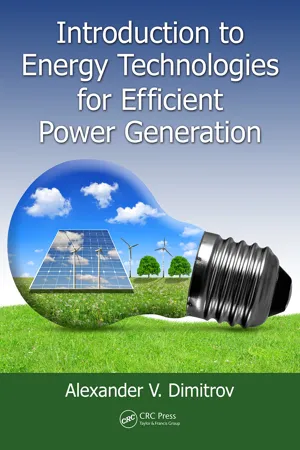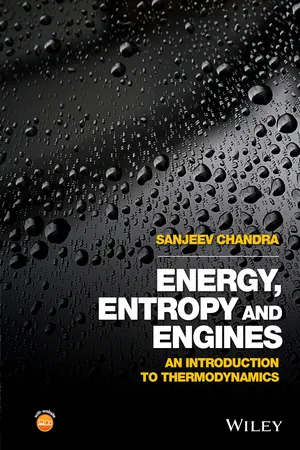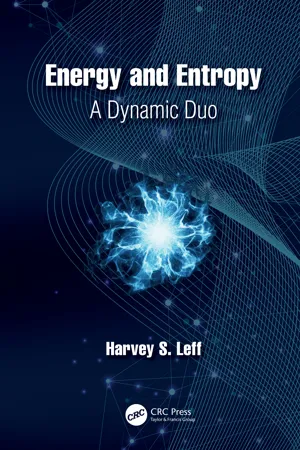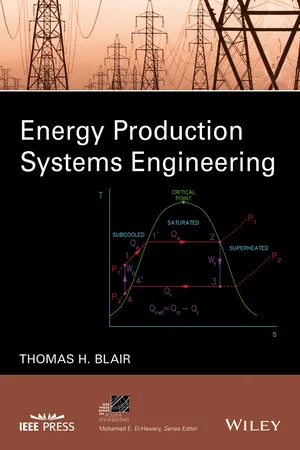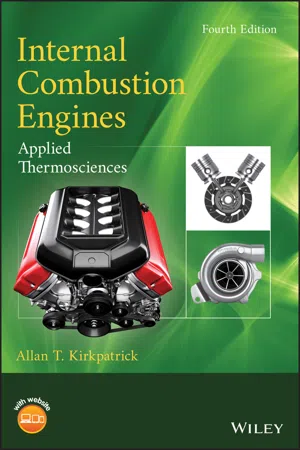Technology & Engineering
Otto Cycle
The Otto Cycle is a thermodynamic cycle used in spark-ignition internal combustion engines. It consists of four processes: isentropic compression, constant volume heat addition, isentropic expansion, and constant volume heat rejection. This cycle is the basis for the operation of gasoline engines and is used to analyze their performance and efficiency.
Written by Perlego with AI-assistance
Related key terms
12 Key excerpts on "Otto Cycle"
- eBook - ePub
Thermodynamic Cycles
Computer-Aided Design and Optimization
- Chih Wu(Author)
- 2003(Publication Date)
- CRC Press(Publisher)
3
Gas Closed-System Cycles
3.1 Otto Cycle
A four-stroke internal combustion engine was built by a German engineer, Nicholas Otto, in 1876. The cycle patterned after his design is called the Otto Cycle. It is the most widely used internal combustion heat engine in automobiles.The piston in a four-stroke internal combustion engine executes four complete strokes as the crankshaft completes two revolutions per cycle, as shown in Fig. 3.1 . On the intake stroke, the intake valve is open and the piston moves downward in the cylinder, drawing in a premixed charge of gasoline and air until the piston reaches its lowest point of the stroke called bottom dead center (BDC). During the compression stroke the intake valve closes and the piston moves toward the top of the cylinder, compressing the fuel-air mixture. As the piston approaches the top of the cylinder called top dead center (TDC), the spark plug is energized and the mixture ignites, creating an increase in the temperature and pressure of the gas. During the expansion stroke the piston is forced down by the high-pressure gas, producing a useful work output. The cycle is then completed when the exhaust valve opens and the piston moves toward the top of the cylinder, expelling the products of combustion.Figure 3.1Otto Cycle.The thermodynamic analysis of an actual Otto Cycle is complicated. To simplify the analysis, we consider an ideal Otto Cycle composed entirely of internally reversible processes. In the Otto Cycle analysis, a closed piston–eylinder assembly is used as a control mass system.The cycle consists of the following four processes: 1-2 Isentropic compression 2-3 Constant-volume heat addition 3-4 Isentropic expansion 4-1 Constant-volume heat removalThe p–v and T–s process diagrams for the ideal Otto Cycle are illustrated in Fig. 3.2 - K.A. Subramanian(Author)
- 2017(Publication Date)
- CRC Press(Publisher)
A spark-ignition engine operates with the thermodynamic cycle of an Otto Cycle, whereas a compression-ignition engine operates with a constant pressure cycle/dual cycle. The principle of operation of a spark-ignition engine and a compression-ignition engine is described next.4.4 Otto CycleA spark-ignition engine operates with an Otto Cycle. Air and fuel are inducted during suction stroke (0-1) and compresses the working fluid (1-2) during compression stroke. Ignition energy generated by a spark plug at end of the compression stroke initiates a chemical reaction of the charge and then combustion proceeds. Heat energy is released at a constant volume, resulting in an increase in in-cylinder pressure and temperature. The working fluid at high temperature and pressure pushes down the piston movement through which the heat energy is converted to mechanical work/power (3-4). The burned product (exhaust gas) during exhaust is expelled out to the atmosphere. Thus, a cycle is completed and then next cycle continues. The details of an Otto Cycle process are given in Table 4.1 . The pressure-volume and temperature-entropy diagram of an Otto Cycle are shown in Figure 4.1 .Table 4.1 Details of Otto Cycle ProcessesProcess Assumption Suction (0-1) Constant pressure Compression (1-2) Isentropic (adiabatic and reversible), s 1 = s 2 Heat addition (2-3) (i) Adiabatic (ii) At constant volume (iii) Complete combustion Expansion (3-4) Isentropic (adiabatic and reversible), s 3 = s 4 Exhaust (1-0) (i) Adiabatic (ii) Valves open and close at top and bottom center (iii) Process (4-1) at constant volume (iv) Process (1-0) at constant pressure Figure 4.1 Pressure-volume diagram (a–c) and temperature-entropy diagram (d–f) for an Otto Cycle based spark-ignition engine.4.4.1 Derivation for Thermal Efficiency of Otto Cycle Based Spark-Ignition Engines4.4.1.1 Process 1-2Isentropic Compression : The working fluid (charge: air-fuel mixture) is compressed by a piston, which moves from bottom dead center (BDC) to top dead center (TDC). The pressure, temperature, and volume at BDC and TDC are denoted as P 1 , T 1 , V 1 and P 2 , T 2 , V 2 , respectively. The specific heat ratio (γ) is defined by the ratio of specific heat at constant pressure (C p ) and specific heat at constant volume (C v ). The total volume of the engine’s cylinder is summation of swept volume and clearance volume. V 1 and V 2 represent the engine’s total volume and clearance volume, and the ratio of V 1 at BDC and V 2- eBook - ePub
- Julian Happian-Smith(Author)
- 2001(Publication Date)
- Butterworth-Heinemann(Publisher)
This is a major consideration when the thermal design of components such as the piston and the engine cooling system are considered. A thermodynamic cycle of a spark ignition engine can be represented in Pressure–Volume coordinates as shown in Figure 12.1. This ideal cycle, known as the Otto Cycle after its inventor Gustav Otto, consists of an isentropic compression process 1–2, a constant volume heat addition process 2–3, an isentropic expansion 3–4, and a constant volume heat rejection process 4–1. The amount of heat received per unit mass of the working fluid per cycle is as shown in equation 12.1. Figure 12.1 An ideal Otto Cycle q + = c v T 3 − T 2 (12.1) Likewise the heat rejected from the cycle will be q = c v T 4 − T 1 (12.2) The network produced by the cycle and the thermal efficiency of the cycle will then be: W net = M c v T 3 − T 2 − T 4 + T 1 (12.3) η th = 1 − q − q + = 1 − T 4 − T 1 T 3 − T 2 (12.4) Using the geometric. relationships in the cycle the expression for the thermal efficiency then becomes as shown in equation 12.5. η th = 1 − 1 r n − 1 (12.5) The efficiency of the cycle is seen to depend upon the compression ratio r and the nature of the working fluid through the polytropic exponent n. The influence of compression ratio on the efficiency is shown in Figure 12.2 for different values of the exponent n. A value of n of 1.4 corresponds to that of an ideal gas with constant specific heats whilst the value of 1.3 is typical of that for products of combustion of petrol–air mixtures. For given values of r and n the efficiency is a constant quantity that is independent of the combustion process and therefore is also independent of the load. Figure 12.2 The influence of compression ratio r on the ideal cycle thermal efficiency for different values of the polytropic exponent The mean effective pressure is often used as a measure of an engine’s performance. It is obtained by dividing the work produced per cycle by the swept volume - eBook - ePub
Thermal Power Plant
Design and Operation
- Dipak Sarkar(Author)
- 2015(Publication Date)
- Elsevier(Publisher)
It is in this stage that the cycle contributes its useful work, rotating the engine crankshaft. In an ideal Otto Cycle this process is isentropic. Figure 8.12 Expansion in Otto Cycle. Source: http://enx.org/resources/beb. In an engine, the cooling process involves exhausting the gas from the engine to the environment and replacing it with fresh air. Since this happens when the piston is at the TDC position in the cycle and remains immobile, this process is also isochoric (no change in volume). 8.2.2.4 Thermal efficiency [5] The thermal efficiency of the Otto Cycle can be expressed by dividing external work by heat input to the working fluid as follows: η t h = Q i n + Q o u t Q i n = 1 + Q o u t Q i n (8.19) (8.19) Hence, considering the unit mass flow of the fluid and assuming constant specific heats for the air, for constant volume heating and cooling we can. use η t h = 1 + C v (T 1 − T 4) C v (T 3 − T 2) = 1 − T 4 − T 1 T 3 − T 2 (8.20) (8.20) We know that for ideal gas Pv=nRT and γ=C p /C v and for adiabatic condition Pv γ =constant. Using Figure 8.8 v 3 =v 2 and v 4 =v 1. Hence, T 2 T 1 = (P 2 P 1) γ − 1 γ = (v 1 v 2) (γ − 1) (8.21) (8.21) or, T 1 = T 2 (v 1 v 2) (γ − 1) (8.22) (8.22) Again, T 4 T 3 = (P 4 P 3) γ − 1 γ = (v 3 v 4) (γ − 1) (8.23) (8.23) or, T[--=PLGO-SEPARA. TOR=--]4 = T 3 (v 2 v 1) (γ − 1) = T 3 (v 1 v 2) (γ − 1) (8.24) (8.24) Using the values of Eq. 8.22 and Eq. 8.24 in Eq. 8.20 and expressing the compression ratio as r c =v 1 /v 2 the thermal efficiency of the Otto Cycle changes to η t h = 1 − 1 (v 1 v 2) (γ − 1) = 1 − 1 r c (γ − 1) (8.25) (8.25) where η th =Thermal efficiency Q in =Heat added to the working fluid Q out =Heat rejected from the working fluid C p =Specific heat at constant pressure C v =Specific heat at constant volume Equation 8.25 shows that the thermal efficiency of the Otto Cycle depends only on the compression ratio and not on the peak temperature T 3. Comparing Eqs. 8.12 / 8.14 and Eq - Alexander V. Dimitrov(Author)
- 2017(Publication Date)
- CRC Press(Publisher)
The whole 20th century was marked by the improvement of internal combustion engines. Better understaning of the thermal cycles and mechanical construction, and the usage of cheap and easily accessible fuel (oil at the end of the 19th century and natural gas at the end of the 20th century) resulted in the market domination of engines as devices that converted heat into mechanical work. We shall analyze in what follows the basic types of engine technologies that employ the direct thermodynamic cycle as an operational basis for most vehicles. We shall also outline the application of these technologies in industry and in the generation of electricity.2.2 Engine Technology of Otto–Langen (Carbureted Engine with Internal Combustion)In contrast to the classical thermomechanical technology of the Watt engine (Figure 1.22 ), where heat generated in an internal combustion device (boiler) was transported to the power cylinder by a heat transferring medium (steam), the Otto–Langen technology * combined the combustion chamber and the power cylinder into a joint device (see Figure 2.1 ).Figure 2.1Carbureted engine operating with Otto–Langen technology: (a) Filling; (b) compression and ignition; (c) combustion and expansion; and (d) exhaust of combustion products. 1—power cylinder/combustion chamber; 2—piston; 3—exhaust passage; 4—exhause valve; 5—intake valve; 6—carburetor; 7—fuel container; 8—rack and pinion mechanism; 9—ignition device.Heat is generated within the power cylinder. Fuel–air mix prepared in a special device (carburetor 6 in Figure 2.1 ) is fed to the combustion chamber 1. The mix burns in the course of two piston strokes—filling and compression (see Figure 2.1a,b ).A spark device 9 initiates combustion at the end of the second process (stroke), which takes place instantaneously and practically at constant volume (v = const). Then, pressure in the combustion chamber rises almost instantaneously and the expansion process starts from piston top dead center (TDC). Since valves 4 and 5 are closed, expansion is accomplished by pushing the movable wall (piston 2 in Figure 2.1c ).Thus, the engine third stroke, where positive work is done. The piston rises occupying an upper limit position (TDC) and returns back driven by external moments and forces, owing to the engine mechanical components. The thermomechanical system contacts the “cold source” (the atmosphere), while the exhaust valve 4 automatically opens and valve 5 closes. This happens during the fourth stroke of the cycle when piston 2 pushes residue gases which outflow through the exhaust port 3.- eBook - ePub
Energy, Entropy and Engines
An Introduction to Thermodynamics
- Sanjeev Chandra(Author)
- 2016(Publication Date)
- Wiley(Publisher)
Assuming that both the expansion and compression strokes are reversible and adiabatic, we can model them as being isentropic processes. Heat addition (due to ignition) and heat rejection (due to the exhaust valve opening) are very rapid processes, during which the piston moves through a very small distance and we can quite reasonably suppose that both are constant volume processes. With these assumptions, a spark-ignition engine can be approximated by the Otto Cycle, which is shown in Figure 10.4 on both P-v (Figure 10.4 a) and T-s (Figure 10.4 b) diagrams. Figure 10.4 The Otto Cycle on (a) a P-v diagram and (b) a T-s diagram. The Otto Cycle consists of four processes: 1→2 Isentropic compression 2→3 Constant volume heat addition 3→4 Isentropic expansion 4→1 Constant volume heat rejection. There is no work done by the engine during heat addition or rejection since both are constant volume processes. The heat added to the engine per unit mass of air is, assuming constant specific heat, (10.2) and the heat rejected is (10.3) The thermal efficiency of an Otto Cycle, (10.4) Substituting Equations (10.2) and (10.3) into Equation (10.4) gives (10.5) The processes 2→3 and 4→1 are both constant volume, so V 1 = V 4 = V max and V 2 = V 3 = V min. Since processes 1→2 and 3→4 are both isentropic, we can write (10.6) where the specific heat ratio γ = c p / c v. Rearranging Equation (10.6) gives (10.7) Substituting Equation (10.7) into Equation (10.5), (10.8) Combining with Equation (10.1), (10.9) Figure 10.5 shows the variation of Otto engine efficiency (η th,Otto) with compression ratio (r), assuming that the specific heat ratio for air γ =1.4. The efficiency increases continuously with r, suggesting that the compression ratio should be made as high as possible. In practice there is a limit to how high the engine compression ratio can be in a spark-ignition engine because the more the gas is compressed the higher its temperature (T 2) becomes at the end of the compression stroke - eBook - ePub
Energy and Entropy
A Dynamic Duo
- Harvey S. Leff(Author)
- 2020(Publication Date)
- CRC Press(Publisher)
coefficient of performance for a refrigerator or air conditioner is defined byCO≡P c.Q −W on(8.10) 8.2.3Reversible & irreversible Otto CyclesClockwise Otto Cycle. Historically, from at least Carnot’s work, heat engines were an important motivator for the development of thermodynamics. In 1876, the German engineer Nikolaus Otto built a 4-stroke internal combustion engine, the familiar engine type used in pre-electric automobiles. The Otto Cycle takes in fuel (petrol), mixes it with air in a carburetor, and burns the mixture in cylinders fitted with movable pistons. The combustion produces hot, high pressure gas that pushes the pistons, doing work. Coupling via a transmission turns the wheels of the vehicle. The combustion products are then exhausted and the process repeats itself with a new mixture of petrol and air. Note the potentially useful mnemonic connection between Otto and auto.The model used for this cycle is illustrated in Fig.8.7 . Path ab connotes the constant volume heating of the working substance. This is a convenient simplification of reality, where a petrol-air mixture is ignited and a chemical reaction releases the energy that heats the gas. In contrast, for the reversible model, an infinite number of reservoirs is needed to effect path ab. For the irreversible quasistatic case with reservoirs at the maximum and minimum temperatures Tb≡ T+ and Td≡ T− , path ab entails transfer of energy from the high temperature reservoir to the working substance, bringing it slowly, and irreversibly, from state a to state b The input and output transfers are defined to be nonnegative: Qin ≥ 0 and Qout ≥ 0.Figure 8.7: Reversible Otto Cycle with constant volume and constant-entropy paths: (a) pressure vs. volume diagram; (b) temperature vs. entropy diagram, and circumscribing Carnot cycle (dashed lines).Path cd cools the gas, either reversibly or irreversibly and quasistatically. In an actual internal combustion engine, after expansion bc, the combustion products are exhausted to the surrounding air, and new outside air is compressed along path da. In the closed-cycle model in Fig.8.7 , the working substance is compressed along path da after being cooled along cd.2 - eBook - ePub
- Thomas Howard Blair(Author)
- 2016(Publication Date)
- Wiley-IEEE Press(Publisher)
13.4 .Figure 13.4 Ideal Diesel thermodynamic cycle.Source: Reproduced with permission of NASADefining the efficiency of the engine as the amount of heat into the engine by the work delivered by the engine, we can compare the efficiencies of the Otto and Diesel-based engines by comparing the amount of work done by both the Otto and Diesel thermodynamic cycle. If we assume the same compression ratios for the Otto and Diesel thermodynamic cycle engines and overlay Figure 13.3 and Figure 13.4 , it would appear that the Otto thermodynamic cycle engine is more efficient than the Diesel since for the same compression ratio, we obtain less work from the Diesel thermodynamic cycle than we do for the Otto thermodynamic cycle. This is shown in Figure 13.5 .Figure 13.5 Comparison of Otto and Diesel thermodynamic cycle with same compression ratio.Source: Reproduced with permission of NASAIn Figure 13.5 , the amount of net work for the Otto thermodynamic cycle is defined by the figure of 3–4–5–6–3. The net work for the Diesel thermodynamic cycle is defined by the figure of 3–4′–5′–6–3. We can visually see that the Otto thermodynamic cycle produces more work. However, unlike the engine based on the Otto thermodynamic cycle, the diesel engine has larger compression ratio values. We stated previously that as we increase the compression ratio of the engine, we increase the efficiency of the machine. A typical value of compression ratio for a diesel engine can reach values of 20 or higher (almost double the values of the standard Otto thermodynamic based machine). If we now overlay the two thermodynamic cycles and assume a larger value of compression ratio for the diesel engine, we should see that we can obtain a greater amount of work out of the diesel engine and this is in fact true as Figure 13.6 - eBook - ePub
The Pilot's Manual: Multi-Engine Flying
All the aeronautical knowledge required to earn a multi-engine rating on your pilot certificate
- Mark Dusenbury, Shayne Daku, Robert Laux(Authors)
- 2015(Publication Date)
- Aviation Supplies & Academics, Inc.(Publisher)
called the Otto Cycle which can be broken down into four basic steps: intake, compression, combustion, exhaust. Each step—or stroke—is measured by the movement of the piston from the top position of the cylinder to the bottom. These two positions are referred to as top dead center (TDC) and bottom dead center (BDC) (Figure 2-1). Figure 2-1. The four piston movements of a four-stroke internal combustion engine. The four strokes of the cycle: Intake stroke : The piston begins at TDC and moves down the cylinder, drawing a mixture of air and fuel into the cylinder through an opening in the top of the cylinder called the intake valve; in the case of a fuel-injected engine, only air is drawn in on the intake stroke and fuel is added once the air has reached the cylinder. Once the piston reaches BDC, the intake valve closes and the intake stroke is complete. Compression stroke : With the intake and exhaust valves closed, the piston now travels back up the cylinder, compressing the mixture of air and fuel. The compression stroke ends when the piston reaches TDC. Power stroke : Just before the piston reaches TDC the air fuel mixture is ignited, causing a rapid thermal expansion of the mixture. This “rapid burn” creates a force that pushes the piston back down the cylinder towards BDC. This stroke ends when the piston reaches BDC. Exhaust stroke : as the piston reverses its direction and heads back up the cylinder, the exhaust valve opens allowing the spent air fuel mixture to be forced out of the cylinder. This stroke ends when the piston reaches TDC, and the cycle repeats, starting again with the intake stroke. The pistons are attached to a crankshaft that converts the linear action—up and down motion—into a rotational force. This rotational force is then used to spin the propeller, fuel pump, vacuum pump and alternator. This is referred to as the accessory drive - eBook - ePub
Internal Combustion Engines
Applied Thermosciences
- Allan T. Kirkpatrick(Author)
- 2020(Publication Date)
- Wiley(Publisher)
is due to the change in chemical composition from an unburned fuel–air mixture to an equilibrium combustion product mixture, with accompanying increased molecular kinetic activity.The basic processes of a simple fuel–air Otto Cycle necessary to compute the efficiency and the indicated mean effective pressure are:
The work of the fuel–air Otto Cycle is1 to 2 isentropic compression from to , with 2 to 3 Adiabatic, constant volume combustion, = constant, with 3 to 4 Isentropic expansion from to , with (4.25)and the imep is(4.26)The above equations are solved numerically in the fuel–air Otto Cycle program OttoFuelAir.m listed in the Appendix. The engine parameters that are input to the Otto fuel–air cycle program are the compression ratio , the fuel–air equivalence ratio , the residual mass fraction , the fuel type, and the initial mixture temperature and pressure - eBook - ePub
- Irving Granet, Jorge Alvarado, Maurice Bluestein(Authors)
- 2020(Publication Date)
- CRC Press(Publisher)
Figure 9.23 . The air-standard efficiency of the ideal Ericsson engine therefore is equal to the Carnot efficiency.The use of regeneration in the steam cycle or in the Stirling and Ericsson cycles is seen to cause the efficiencies of these cycles to approach the efficiency of the Carnot cycle. In the case of the Stirling and Ericsson cycles, the reduction of theory to actual working engines presents practical difficulties that cause the actual engine efficiencies to be below that of the Carnot cycle.9.10 Review
In Chapter 8 , we considered vapor cycles in which the working fluid underwent a change in phase. In this chapter, we have concerned ourselves with cycles in which the working fluid is a gas and remains a gas throughout the cycle. Some of the cycles considered in this chapter have internal combustion; others have external combustion. Some have spark ignition; others have compression ignition. In order to simplify the calculations and to permit us to arrive at general conclusions, we utilized the air-standard cycle analysis. The air-standard cycle analysis assumes that air is the working fluid and that it behaves as an ideal gas. Each process of the cycle is assumed to be internally reversible, and the specific heats of the air are assumed to be constant throughout the cycle. In effect, the same air remains in the engine from cycle to cycle in the air-standard analysis.Based on the air-standard analysis, the efficiency of the Otto Cycle was determined to be a function only of the compression ratio, r c . The efficiency of the Diesel cycle was found to be less than the efficiency of the Otto Cycle for the same compression ratio. However, the compression ratio of Diesel engines is much greater than the compression ratio of the Otto Cycle because the fuel is injected at the end of the compression stroke rather than compressing the fuel– air mixture. The efficiency of the Brayton cycle was found to be proportional to the pressure ratio, r p - Mehrdad Ehsani, Yimin Gao, Stefano Longo, Kambiz Ebrahimi(Authors)
- 2018(Publication Date)
- CRC Press(Publisher)
Figure 3.1 . It consists of a powering system (crankshaft, connection rod, piston, and cylinders), intake and exhaust system (air filter, throttle, inlet and exhaust manifolds, inlet and exhaust valves, and valve control cams), fuel supply (fuel tank [not shown], fuel pump [not shown], and fuel injectors), ignition system (battery [not shown], ignition coils [not shown], and spark plugs), cooling system (coolant, water pump radiator [not shown]), and lubricating system (not shown).Figure 3.1 Spark-ignited gasoline engine.In most cases, the combustion of the air–fuel mixture formed within the inlet manifold and trapped in the cylinder produces heat, and then the temperature and pressure in the cylinder increase quickly. Thus, the piston is forced to move down. The connection rod transfers the linear movement of the piston into rotation of the crankshaft.A four-stroke SI engine has four instinctive processes corresponding to the four strokes of each piston,1 ,2as shown in Figure 3.2 .1.Induction-stroke (cylinder filling process): While the piston travels down the cylinder from its top dead center (TDC), the valve cam opens the inlet valves and closes the exhaust valves. The air–fuel mixture formed in the inlet manifold is drawn into the cylinder, as shown in Figure 3.2a , until the piston arrives at its bottom dead center (BDC), where the valve cam closes the inlet valves (both inlet and exhaust valves are in a closed state).2.Compression-stroke: While both the inlet and exhaust valves are closed, and the piston travels up the cylinder from its BDC, the in-charged air–fuel mixture in the cylinder is compressed, as shown in Figure 3.2b . As the piston approaches its TDC, the spark plug produces a spark, igniting the compressed air–fuel mixture in the cylinder, as shown in Figure 3.2c
Index pages curate the most relevant extracts from our library of academic textbooks. They’ve been created using an in-house natural language model (NLM), each adding context and meaning to key research topics.
